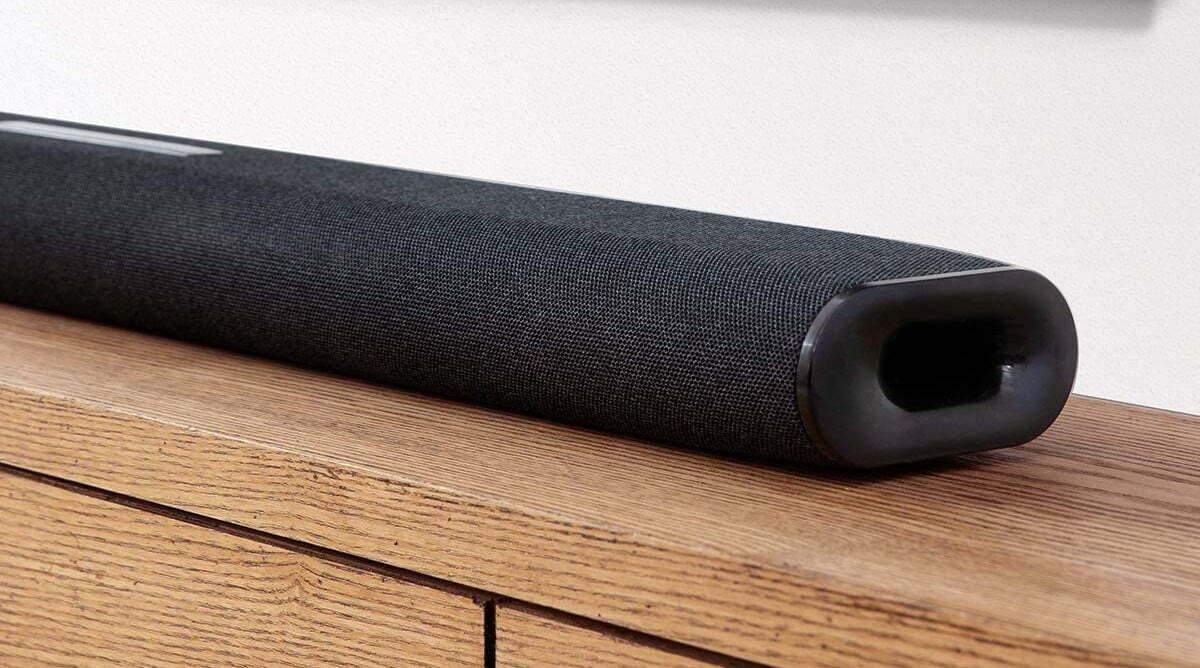Home>Production & Technology>Sound Bar>What Is The Difference Between A 5.1 And 2.1 Sound Bar


Sound Bar
What Is The Difference Between A 5.1 And 2.1 Sound Bar
Modified: February 18, 2024
Learn the key distinctions between 5.1 and 2.1 sound bars and make an informed decision for amplified sound in your home. Explore now!
(Many of the links in this article redirect to a specific reviewed product. Your purchase of these products through affiliate links helps to generate commission for AudioLover.com, at no extra cost. Learn more)
Table of Contents
Introduction
Sound bars have become increasingly popular audio solutions for home entertainment systems. They provide a compact and convenient way to enhance your audio experience without the need for multiple speakers and complex wiring setups. However, when it comes to choosing a sound bar, you may come across different configurations such as 5.1 and 2.1. Understanding the differences between these configurations is essential to ensure you make the right choice for your audio needs.
Before we delve into the comparison, let’s take a moment to understand what a sound bar is. A sound bar is a long, slim speaker system that is designed to sit below or above your TV, providing a more immersive audio experience compared to your TV’s built-in speakers. It typically consists of multiple speakers housed in a single unit, along with various audio technologies to enhance sound quality.
In this article, we will explore the key differences between a 5.1 sound bar and a 2.1 sound bar. By understanding these differences, you’ll be well-equipped to make an informed decision that suits your audio preferences and budget.
Definition of a Sound Bar
A sound bar is a type of speaker system that is designed to deliver high-quality audio for home entertainment systems. It is an all-in-one solution that can replace the need for multiple speakers and complicated surround sound setups.
Unlike traditional home theater systems, which often consist of a receiver, multiple speakers, and complex wiring, a sound bar offers a simplified and streamlined audio solution. It is a single, elongated speaker that is typically placed either below or above the television. Sound bars are designed to enhance the audio output of your TV, providing a more immersive sound experience.
Most sound bars are equipped with multiple speakers housed within a single unit. This allows them to reproduce a wider range of frequencies and create a more dynamic soundstage. Some sound bars also come with built-in subwoofers, which are dedicated speakers for low-frequency sounds such as deep bass. The combination of multiple speakers and, in some cases, a subwoofer, results in a rich and immersive audio experience.
Sound bars are available in various sizes and configurations to suit different needs and preferences. They can be integrated with existing home theater systems, or they can be used as stand-alone audio solutions. Many sound bars also offer wireless connectivity, allowing you to easily connect and stream audio from your smartphone, tablet, or other devices.
Overall, sound bars are designed to provide a convenient and space-saving audio solution without compromising on sound quality. They are an excellent choice for those who want to enhance their home entertainment experience without the complexity and clutter of traditional speaker systems.
What Is a 5.1 Sound Bar?
A 5.1 sound bar, also known as a 5.1-channel sound bar, refers to a sound bar system that consists of five speakers and one subwoofer. The “5.1” in the name denotes the number of main speakers and the subwoofer, respectively. This configuration aims to replicate the immersive surround sound experience typically found in traditional 5.1 home theater setups.
The five main speakers in a 5.1 sound bar are responsible for reproducing the different audio channels, including the front left, front right, center, and rear left and right channels. These speakers are positioned within the sound bar, strategically placed to create a virtual surround sound effect, enhancing the audio immersion for the listener.
In addition to the main speakers, the 5.1 sound bar includes a subwoofer. The subwoofer is responsible for reproducing low-frequency sound, particularly deep bass. This adds depth and impact to the overall sound experience, bringing movies, music, and games to life with a more realistic and powerful audio presence.
One of the key advantages of a 5.1 sound bar is its ability to deliver a surround sound experience without the need for multiple speakers and complicated wiring. This makes it a popular choice for those who want a simplified setup while still enjoying immersive audio. Furthermore, some 5.1 sound bars come with advanced audio technologies, such as Dolby Atmos or DTS:X, which further enhance the soundstage and provide a three-dimensional audio experience.
However, it’s important to note that while a 5.1 sound bar can provide an enhanced audio experience, it may not be as immersive as a full-fledged 5.1 home theater system due to the limitations of having all the speakers housed within a single unit. Nevertheless, a 5.1 sound bar can still deliver impressive audio performance, making it a popular choice for those who want a balance between audio quality and simplicity.
What Is a 2.1 Sound Bar?
A 2.1 sound bar is a type of sound bar system that consists of two main speakers and one subwoofer. The “2.1” in the name denotes the number of main speakers and the subwoofer, respectively. This configuration is designed to deliver enhanced audio performance and a more immersive sound experience compared to standard TV speakers.
The two main speakers in a 2.1 sound bar are responsible for reproducing the left and right audio channels. These speakers are typically positioned within the sound bar, allowing for a wider soundstage and improved audio separation. This creates a more immersive listening experience, where you can better distinguish different audio elements and enjoy a more detailed and engaging sound quality.
In addition to the main speakers, a 2.1 sound bar includes a subwoofer. The subwoofer is dedicated to reproducing low-frequency sounds, particularly deep bass, which adds depth and impact to your audio. With a subwoofer, you can experience more powerful and realistic bass, enhancing your overall audio experience, whether you’re watching movies, listening to music, or playing games.
Compared to a 5.1 sound bar, a 2.1 configuration offers a more streamlined and compact setup. It can be a great choice if you have limited space or prefer a simpler installation process. The two main speakers and the subwoofer work together harmoniously to create a balanced audio output, delivering impressive sound quality without the need for multiple speakers and complicated wiring.
While a 2.1 sound bar may not provide the same level of surround sound immersion as a 5.1 system, it still offers a significant improvement over standard TV speakers. It allows you to enjoy clearer dialogue, enhanced music reproduction, and impactful low-frequency effects. Additionally, some 2.1 sound bars come with advanced audio technologies, such as virtual surround sound or sound modes tailored for specific content, further enhancing the audio experience.
Overall, a 2.1 sound bar is an excellent choice for those who want an upgraded audio experience without the complexity and space requirements of a full surround sound system. With its compact size, simplified setup, and impressive sound quality, a 2.1 sound bar is a versatile option that can greatly enhance your home entertainment enjoyment.
Key Differences Between a 5.1 and 2.1 Sound Bar
While both 5.1 and 2.1 sound bars offer improved audio performance compared to TV speakers, there are some key differences to consider when choosing between these configurations.
One of the main differences lies in the number of speakers. A 5.1 sound bar comes with five main speakers and one subwoofer, whereas a 2.1 sound bar has two main speakers and one subwoofer. Having more speakers in a 5.1 configuration allows for a more immersive surround sound experience, with audio coming from various directions. In contrast, a 2.1 setup provides a wider soundstage compared to TV speakers but may not offer the same level of surround sound immersion.
Another difference is the overall audio performance. With the additional speakers, a 5.1 sound bar can provide a more detailed and dynamic sound experience. The presence of dedicated rear speakers in a 5.1 setup adds depth and realism to the audio, making it ideal for movies or gaming. On the other hand, a 2.1 sound bar still offers improved audio quality compared to TV speakers, but it may not deliver the same level of surround sound immersion as a 5.1 system.
Price and space considerations are also worth noting. A 5.1 sound bar typically comes with more components, resulting in a higher price point and potentially requiring more space for setup. On the other hand, a 2.1 configuration offers a more compact and budget-friendly option, making it suitable for smaller spaces or those on a tighter budget.
When it comes to installation and setup, a 5.1 sound bar may involve more complexity due to the placement of multiple speakers and the need for proper wiring. This can be a disadvantage for those who prefer a simpler installation process. In contrast, a 2.1 sound bar offers a more streamlined and straightforward setup, often requiring only a few connections.
Ultimately, the choice between a 5.1 and 2.1 sound bar depends on your specific needs and preferences. If you prioritize a fully immersive surround sound experience and have ample space and budget, a 5.1 sound bar may be the ideal choice. However, if you value simplicity, compactness, and cost-effectiveness, a 2.1 sound bar can provide a significant audio upgrade while still offering a more streamlined setup.
Sound Quality Comparison
When comparing the sound quality of a 5.1 and 2.1 sound bar, several factors come into play, including the number of speakers, subwoofer performance, and overall audio immersion.
A 5.1 sound bar, with its five main speakers and dedicated subwoofer, offers a more encompassing sound experience. The presence of dedicated rear speakers in a 5.1 configuration enhances the surround sound effect, making you feel like you’re in the middle of the action. This setup results in a more immersive audio experience, particularly for movies and games where directional sound effects are crucial.
The additional speakers in a 5.1 sound bar also contribute to a more detailed sound reproduction. Each speaker handles specific audio channels, allowing for better audio separation and clearer dialogue. Furthermore, the dedicated subwoofer brings deep bass notes to life, adding depth and impact to the overall sound quality, especially during action-packed scenes or music with heavy bass elements.
On the other hand, a 2.1 sound bar, with its two main speakers and subwoofer, still provides a noticeable improvement in sound quality compared to TV speakers. The two main speakers deliver a wider soundstage, resulting in a more immersive listening experience compared to the limited stereo output of TV speakers.
While a 2.1 sound bar may not offer the same level of surround sound immersion as a 5.1 configuration, it can still deliver impressive audio performance. The addition of a subwoofer ensures that low-frequency sounds, such as deep bass, are reproduced faithfully, giving your audio more depth and impact. With this enhanced bass response, you can enjoy music, movies, and games with a fuller and more dynamic sound.
When it comes to sound quality, it’s important to consider not only the number of speakers but also the overall audio experience you desire. If you value a fully immersive surround sound experience with detailed audio separation, a 5.1 sound bar is the way to go. However, if you prioritize enhanced audio quality with a wider soundstage and impactful bass, a 2.1 sound bar can still deliver a significant upgrade over standard TV speakers.
Ultimately, the sound quality comparison between a 5.1 and 2.1 sound bar will depend on your personal preferences and the type of audio content you most frequently enjoy. Both configurations provide an improvement over TV speakers, allowing you to enjoy a more immersive and enjoyable audio experience.
Speaker Placement and Configuration
The placement and configuration of speakers are important considerations when it comes to both 5.1 and 2.1 sound bars. These factors directly affect the audio performance and the overall sound experience.
In a 5.1 sound bar system, there are five main speakers to consider: the front left, front right, center, and rear left and right speakers. The front left and right speakers should be placed on either side of your TV, facing towards the listener. The center speaker is typically positioned either above or below the TV, directly in the middle, to ensure clear and focused dialogue reproduction.
The placement of the rear speakers in a 5.1 sound bar may vary depending on the specific model. Some sound bars come with separate rear speakers that need to be placed behind the listener, ideally at an equal distance from the primary listening position. Other sound bars with a virtual surround sound feature may not require physical rear speakers, as the sound bar itself is designed to create a surround sound effect.
As for the subwoofer, it is recommended to place it on the floor in a location that will provide the best low-frequency sound reinforcement. This could be near the TV or in a corner of the room, depending on the layout and acoustics of the space.
On the other hand, a 2.1 sound bar configuration consists of two main speakers and a subwoofer. The main speakers should be positioned on either side of the TV, facing towards the listener, to create a wider soundstage. The subwoofer can be placed anywhere in the room, as long as it provides optimal bass response. Experimenting with subwoofer placement can help achieve the best balance of bass impact and room acoustics.
When it comes to speaker configuration and placement, it is recommended to follow the manufacturer’s guidelines and instructions for the specific sound bar model you have. Proper speaker placement and configuration ensure balanced audio dispersion, maximize the surround sound effect (in the case of a 5.1 system), and provide the best overall sound quality.
Keep in mind that the placement of speakers may be limited by the size and layout of your room. It is important to find a balance that allows for optimal audio performance while considering the aesthetics and practicality of your space.
By setting up your sound bar speakers correctly and configuring them based on the manufacturer’s guidelines, you can enhance your audio experience and ensure that you’re getting the best possible sound quality from your system.
Surround Sound Experience
The surround sound experience is a significant factor to consider when choosing between a 5.1 and 2.1 sound bar. Surround sound creates a more immersive audio environment, making you feel like you’re in the middle of the action.
A 5.1 sound bar configuration is designed to replicate the surround sound experience found in traditional home theater systems. With the inclusion of dedicated rear speakers, the audio is spread out across the room, creating a more realistic and immersive soundstage. This setup enables you to hear distinct audio elements coming from different directions, enhancing your overall audio immersion.
When watching movies or playing games, the surround sound effect of a 5.1 system can make you feel more engaged by replicating sounds as they would occur in real life. For example, you can hear a car speeding from behind you or the rustling of leaves coming from your sides. This level of audio immersion adds depth to your overall viewing or gaming experience.
On the other hand, a 2.1 sound bar configuration may not provide the same level of surround sound immersion as a 5.1 setup. However, it still offers an enhanced audio experience compared to standard TV speakers. The two main speakers in a 2.1 system create a wider soundstage than TV speakers, resulting in a more immersive audio listening experience.
While a 2.1 sound bar may not have dedicated rear speakers, some models incorporate virtual surround sound technology. This feature uses advanced audio processing algorithms to simulate the effect of multiple speakers and create the perception of a surround sound experience. While not as immersive as physical rear speakers, virtual surround sound can still enhance your audio experience and provide a wider soundstage.
Ultimately, whether you opt for a 5.1 or 2.1 sound bar configuration depends on the level of surround sound experience you desire. If you seek a fully immersive surround sound experience with audio coming from multiple directions, a 5.1 setup is the ideal choice. However, if you prioritize an enhanced audio experience without the complexity of multiple speakers, a 2.1 sound bar can still deliver a satisfying surround sound-like experience.
It’s essential to consider your space limitations, budget, and personal preferences when choosing between these configurations. Both options offer an upgrade over standard TV speakers and can significantly enhance your audio enjoyment.
Price Range and Accessibility
Price range and accessibility are important factors to consider when comparing a 5.1 and 2.1 sound bar. The cost and availability of these configurations can vary depending on the brand, features, and overall audio quality.
Generally, 2.1 sound bars tend to be more affordable compared to 5.1 systems. The smaller speaker setup and simpler configuration of a 2.1 sound bar contribute to a lower price point. This makes a 2.1 configuration a more accessible option for those on a tighter budget or who are looking for a cost-effective audio upgrade.
Additionally, due to its simplified setup and smaller speaker count, a 2.1 sound bar is generally more accessible and easier to find in the market. There is a wide range of options available from various brands, making it easier to find a 2.1 sound bar that fits your needs and preferences.
In contrast, 5.1 sound bar systems usually come with five main speakers and a subwoofer, which can result in a higher price tag. The added speakers and potential inclusion of advanced audio technologies can contribute to the higher cost of a 5.1 configuration. However, investing in a 5.1 sound bar can provide a more immersive surround sound experience, especially for avid movie enthusiasts and gamers.
While a 5.1 sound bar may have a higher price range, there are still options available at various price points to suit different budgets. Additionally, the availability of 5.1 sound bars has improved over the years, with more brands offering these configurations to cater to different consumer needs and preferences.
It’s important to assess your budget and priorities when considering the price range and accessibility of a sound bar. If you have a more flexible budget and highly value a fully immersive surround sound experience, a 5.1 sound bar may be the right choice for you. However, if you prioritize affordability and accessibility, a 2.1 sound bar can still deliver a significant audio upgrade without breaking the bank.
Overall, the price range and accessibility of 5.1 and 2.1 sound bars offer options for different budgets and preferences. It’s recommended to compare the features, audio performance, and price range of different sound bars to find the option that best suits your needs and budget.
Conclusion
Choosing between a 5.1 and 2.1 sound bar ultimately comes down to your specific audio preferences, budget, and space constraints. Both configurations offer an upgrade over standard TV speakers, providing a more immersive and enjoyable audio experience.
If you value a fully immersive surround sound experience with audio coming from various directions, a 5.1 sound bar is the ideal choice. With its five main speakers and dedicated subwoofer, a 5.1 configuration can create a more realistic and dynamic soundstage. It is well-suited for avid movie watchers and gamers who desire a more immersive audio environment.
On the other hand, if you prioritize simplicity, compactness, and affordability, a 2.1 sound bar is a great option. It offers a wider soundstage compared to TV speakers and comes with a subwoofer for enhanced bass. A 2.1 configuration can provide a significant audio upgrade without the complexity and higher price of a 5.1 system.
When considering the placement and configuration of speakers, it’s important to follow the manufacturer’s guidelines to ensure optimal audio dispersion. Proper setup and calibration can greatly enhance your audio experience and maximize the potential of your chosen sound bar.
Price range and accessibility are also factors to consider. A 2.1 sound bar tends to be more affordable and more widely available, making it accessible for those on a budget. 5.1 sound bars can have a higher price range due to their additional speakers, but there are still options available at various price points.
In conclusion, the choice between a 5.1 and 2.1 sound bar depends on your personal preferences, budget, and space limitations. Consider the level of surround sound immersion you desire, the overall audio quality, and the cost when making your decision. By carefully evaluating these factors, you can choose the sound bar configuration that will elevate your home entertainment experience and provide the audio enjoyment you seek.











